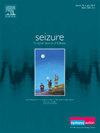癫痫患儿的异位性心动过速。
IF 2.7
3区 医学
Q2 CLINICAL NEUROLOGY
引用次数: 0
摘要
背景:心率(HR)的变化可作为癫痫发作的脑外指标。本研究的目的是评估不同年龄组癫痫患儿发作性心动过速的频率和出现时间,以及发作特征的影响:我们回顾性分析了 195 名 0-14 岁(中位数 6.91 岁)各种原因导致的癫痫患者的 732 次发作。根据年龄将患者分为以下几组:(1) 结果:70.3%的患者在至少一次癫痫发作中出现过直觉性心动过速,51.1%的患者在癫痫发作中出现过直觉性心动过速。在局灶性发作和睡眠中发作的患者中,直觉性心动过速更为频繁和更早出现。>30%以上的患者在所有发作中都出现发作性心动过速,这在 6-10 岁和 10-14 岁年龄组中更为常见:结论:6 岁以上的儿童,尤其是在睡眠期间有局灶性癫痫发作的儿童,是通过检测心动过速触发警报装置或刺激疗法的理想人选。今后的研究应着眼于评估与 SUDEP 风险有关的影响。本文章由计算机程序翻译,如有差异,请以英文原文为准。
Ictal tachycardia in children with epilepsy
Background
Changes in heart rate (HR) may provide an extracerebral indicator of seizure onset. The purpose of this study is to assess the frequency and timing of presentation of ictal tachycardia in a larger series of children with epilepsy grouped in different age groups as well as the influence of seizure characteristics.
Methods
We retrospectively reviewed 732 seizures of 195 patients aged 0 to 14 (median 6.91) years with epilepsy of any cause. Patients were grouped according to the age in groups (1) <1 year (n = 18); (2) 1–2 years (n = 26); (3) 2–6 years (n = 43); (4) 6–10 years (n = 44); and (5) 10–14 years (n = 64). HR was assessed visually during the seizures and compared with HR 1 min before seizure onset. The time from seizure onset to ictal tachycardia, defined as an increase in HR by at least 33 %, was described. Ictal tachycardia was considered early if occurring in the first 10 s.
Results
Ictal tachycardia occurred in at least one seizure in 70.3 % of patients and in 51.1 % of seizures. It was more frequent and earlier in focal seizures and in seizures occurring in sleep. >30 % of patients had ictal tachycardia in all of their seizures, this being more frequent in the age groups 6–10 and 10–14 years.
Conclusions
Children older than 6 years especially with focal seizures during sleep could be ideal candidates for warning devices or stimulation therapies triggered by tachycardia detection. Future studies should aim to assess the implications in relation to the risk of SUDEP.
求助全文
通过发布文献求助,成功后即可免费获取论文全文。
去求助
来源期刊

Seizure-European Journal of Epilepsy
医学-临床神经学
CiteScore
5.60
自引率
6.70%
发文量
231
审稿时长
34 days
期刊介绍:
Seizure - European Journal of Epilepsy is an international journal owned by Epilepsy Action (the largest member led epilepsy organisation in the UK). It provides a forum for papers on all topics related to epilepsy and seizure disorders.
 求助内容:
求助内容: 应助结果提醒方式:
应助结果提醒方式:


